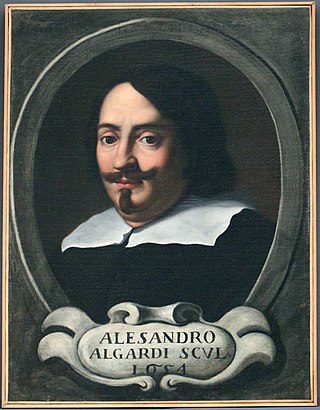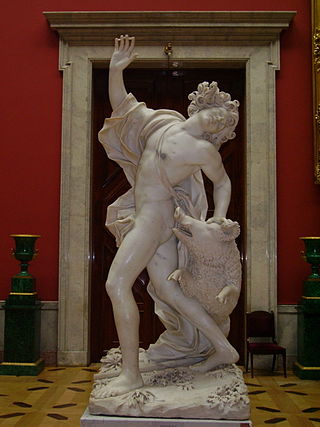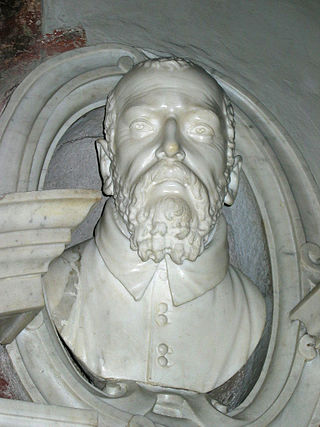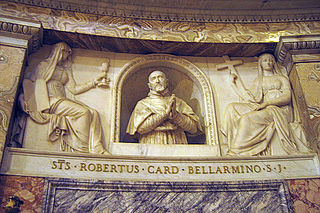
Alessandro Algardi was an Italian high-Baroque sculptor active almost exclusively in Rome. In the latter decades of his life, he was, along with Francesco Borromini and Pietro da Cortona, one of the major rivals of Gian Lorenzo Bernini, in Rome. He is now most admired for his portrait busts that have great vivacity and dignity.

Gian LorenzoBernini was an Italian sculptor and architect. While a major figure in the world of architecture, he was more prominently the leading sculptor of his age, credited with creating the Baroque style of sculpture.

Francesco Mochi was an Italian early-Baroque sculptor active mostly in Rome, Piacenza and Orvieto. His dramatic early works in Orvieto are now often regarded as the first truly Baroque sculptures.

Blessed Ludovica Albertoni is a funerary monument by the Italian Baroque artist Gian Lorenzo Bernini. The Trastevere sculpture is located in the specially designed Altieri Chapel in the Church of San Francesco a Ripa in Rome, Italy. Bernini started the project in 1671, but his work on two other major works—The Tomb of Pope Alexander VII and the Altar of the Blessed Sacrament in St. Peter's Basilica—delayed his work on the funerary monument. Bernini completed the sculpture in 1674; it was installed by 31 August 1674.

The Rape of Proserpina, more accurately translated as the Abduction of Proserpina, is a large Baroque marble group sculpture by Italian artist Gian Lorenzo Bernini, executed between 1621 and 1622, when Bernini's career was in its early stage. The group, finished when Bernini was just 23 years old, depicts the abduction of Proserpina, who is seized and taken to the underworld by the god Pluto. It features Pluto holding Proserpina aloft, and a Cerberus to symbolize the border into the underworld that Pluto carries Proserpina into.

Giuseppe Mazzuoli was an Italian sculptor working in Rome in the Bernini-derived Baroque style. He produced many highly accomplished sculptures of up to monumental scale but was never a leading figure in the Roman art world.

The Bust of Giovanni Battisti Santoni is a sculptural portrait by the Italian artist Gian Lorenzo Bernini. Believed to be one of the artist's earliest works, the bust forms part of a tomb for Santoni, who was majordomo to Pope Sixtus V from 1590 to 1592. The work was executed sometime between 1613 and 1616, although some have dated the work as early as 1609, including Filippo Baldinucci. The work remains in its original setting in the church of Santa Prassede in Rome.

The Bust of Camilla Barbadoni is a marble sculpture by the Italian artist Gian Lorenzo Bernini. Executed in 1619, it portrays the (deceased) mother of the Maffeo Barberini. Camilla had died in 1609. Barberini would become Pope Urban VIII in 1623.

The Bust of Francesco Barberini is a marble sculpture by the Italian artist Gian Lorenzo Bernini, now in the National Gallery of Art in Washington, D.C. It was executed in 1623. It was commissioned by Pope Urban VIII, who was a nephew of Francesco Barberini, an apostolic protonotary. Francesco had died in 1600, so Bernini created the bust from an existing painted portrait. That portrait is in the Corsini Collection in Florence; Bernini made close use of the design, although the painting was a three-quarter portrait as opposed to a bust of head, shoulders, and upper body.

Medusa is a marble sculpture of the eponymous character from the classical myth. It was executed by the Italian sculptor Gian Lorenzo Bernini. Its precise date of creation is unknown, but it is likely to have been executed in the 1640s. It was first documented in 1731 when presented to the Palazzo dei Conservatori in Rome, and is now part of the collections of the Capitoline Museums.

The Italian artist Gian Lorenzo Bernini made two Busts of Pope Paul V. The first is currently in the Galleria Borghese in Rome. 1618 is the commonly accepted date for the portrait of the pope. In 2015, a second bust was acquired by the J. Paul Getty Museum in Los Angeles. It was created by Bernini 1621, shortly after the death of Paul V, and commissioned by his nephew, Cardinal Scipione Borghese. A bronze version of this sculpture exists in the Statens Museum for Kunst, Copenhagen, Denmark.

Damned Soul is a marble sculpture bust by the Italian artist Gian Lorenzo Bernini as a pendant piece to his Blessed Soul. According to Rudolf Wittkower, the sculpture is in the Palazzo di Spagna in Rome. This may well be what is known today as the Palazzo Monaldeschi.

The Bust of Cardinal Roberto Bellarmine is a half-length portrait of Saint Robert Bellarmine by the Italian artist Gian Lorenzo Bernini. It was executed in the years 1621–1624, and unveiled in August 1624. It sits in the Chiesa del Gesù, Rome. It was commissioned by Pope Gregory XV and Cardinal Odoardo Farnese after Bellarmine's death. A tomb (now-destroyed) surrounding the bust was designed by Girolamo Rainaldi, and included sculptural decoration by Bernini's father, Pietro, and Bernini's some-time assistant, Giuliano Finelli.

The Bust of Gabriele Fonseca is a sculptural portrait by the Italian artist Gian Lorenzo Bernini. Executed sometime between 1668 and 1674, the work is located in San Lorenzo in Lucina in Rome, Italy. Gabriele Fonseca was Pope Innocent X's personal physician.

The Bust of Antonio Barberini is a portrait sculpture by the Italian artist Gian Lorenzo Bernini. The figure is Cardinal Antonio Barberini, the younger brother of the Pope Urban VIII. It was executed some time in the 1620s.

The Statue of Urban VIII is a large statue from the late 1630s, of the then pope Urban VIII. It was executed by Gian Lorenzo Bernini and his workshop. The work was commissioned in 1635 and took five years to complete. The piece sits in the Palazzo dei Conservatori in Rome.

The Busts of Pope Innocent X are two portrait busts by the Italian artist Gianlorenzo Bernini of Pope Innocent X, Giovanni Battista Pamphili. Created around 1650, both sculptures are now in the Galleria Doria Pamphili in Rome. Like the two busts of Cardinal Scipione Borghese, it is believed that Bernini created a second version of the bust once a flaw was discovered in the first version. There exist several similar versions of the bust done by other artists, most notably Alessandro Algardi.

Several sculpted busts of Pope Urban VIII were created by the Italian artist Gianlorenzo Bernini, with varying amounts of assistance from other artists in his workshop:
- Palazzo Barberini, Rome, 1623–1624. Marble.
- San Lorenzo in Fonte, 1626. Marble. Assistance by Giuliano Finelli.
- Galleria Nazionale di Arte, Palazzo Barberini, Rome, 1637–1638. Marble.
- Galleria Nazionale di Arte, Palazzo Barberini, Rome. Early 1640s. Marble. Largely the work of an assistant.
- Louvre, Paris. 1640. Bronze.
- Cathedral of Spoleto, 1642. Bronze.
- Collection Principe Enrico Barberini. Early 1640s. Porphyry. Adapted from existing antique statue, largely by assistants.
- Private Collection. 1658. Bronze
The Memorial to Carlo Barberini is a large memorial, featuring two allegorical statues and an inscription. It was designed by the Italian artist Gian Lorenzo Bernini upon the death of Carlo in 1630, and subsequently executed by Bernini and his workshop. It is in the church of Santa Maria in Aracoeli in Rome.

The Statue of Carlo Barberini was a large statue of the brother of Pope Urban VIII, Carlo Barberini, erected in the Palazzo dei Conservatori, Rome, following his death in 1630. The statue made use of an existing antique statue of Julius Caesar. The Roman authorities then commissioned the two most renowned sculptures of the day, Gianlorenzo Bernini and Alessandro Algardi, to add to the torso; Bernini worked on the head and Algardi on the limbs.



















